 1 Trattoria degli Orti
1 Trattoria degli OrtiTutti a tavola!
FUNCTIONS |
• Expressing a desire, preference, need • Stating what you want • Stating a preference • Expressing likes and dislikes |
GRAMMAR |
• Indefinites: niente di buono, qualcosa da mangiare • Present tense of piacere • Present tense of preferire • Present tense of bisogna, aver bisogno di • Modal verbs: dovere, potere, volere • Indirect object pronouns with mancare, occorrere, • servire |
VOCABULARY |
• Menus, food, dishes • Hobbies and leisure interests |
 1 Trattoria degli Orti
1 Trattoria degli Orti
Read the Trattoria degli Orti menu to find out what the dishes listed below are called in Italian.
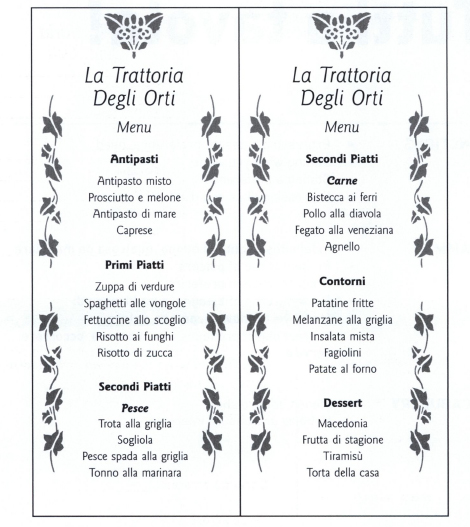
1 ham
2 clams
3 sole
4 tuna
5 mushrooms
6 steak
7 aubergines
8 trout
9 swordfish
10 French beans
11 fresh fruit
12 mixed salad
13 vegetable soup
14 seafood starter
15 side dish
16 main courses
 2 Ordering a meal
2 Ordering a meal
Listen to this restaurant scene (Audio 6.1) between a couple (Franco and Anna) and a waiter. Pretend you are the waiter and write down in Italian what the couple have ordered, using the same headings as on the waiter’s notepad.
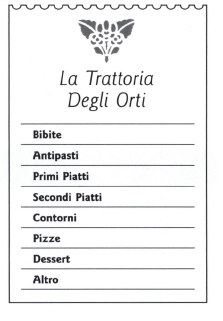
 3 Il conto
3 Il conto
Can you spot the four errors in Franco and Anna’s bill? Write them down in note form in Italian. The first one is done for you.
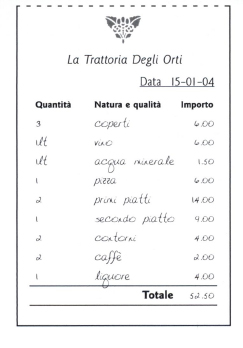
Mistakes
Primo errore: Tre coperti (no due coperti)
Secondo errore: _____________________
Terzo errore: _____________________
Quarto errore: _____________________
 4 Odd one out
4 Odd one out
Circle the odd one out in each line.
1 forchetta, coltello, cucchiaio, tovaglia
2 bicchiere, tovagliolo, bottiglia, caraffa
3 trattoria, pizzeria, pensione, locanda
4 vegetariana, quattro stagioni, capricciosa, al sangue
5 ben cotta, alla griglia, fritta, al vapore
 5 Al ristorante
5 Al ristorante
Read the following adverts and fill in the blanks with the words supplied.
1 cene, parcheggio, piatti, terrazza
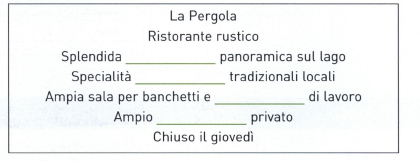
2 biologici, cucina, giardino, olivi

3 specialità, veranda, vini locali

4 all’aperto, forno, settimanale, tarda
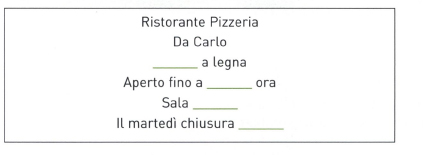
 6 La cucina
6 La cucina
Working with a friend or classmate, ask each other the following questions. See the example.
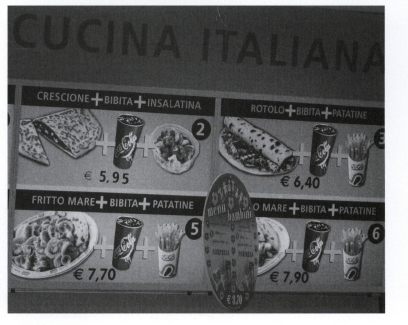
Example
• Ti piacciono di più i pasti a base di carne o di pesce?
• Preferisco i piatti a base di pesce, per esempio il risotto di mare o gli spaghetti con le vongole.
1 Preferisci la cucina italiana o la cucina inglese?
2 Preferisci il fast-food o la cucina tradizionale? Perché?
3 Sei vegetariano/a?
4 Quali piatti della cucina italiana conosci?
5 Cosa conta di più in un ristorante per te, il servizio, la qualità del cibo, il locale, o il prezzo?
 7 AL ristorante
7 AL ristorante
You are in a restaurant. In pairs, Student A will play the customer, Student B will read the waiter’s part which is done for you (C = Cameriere). At the end you can exchange roles.
A: |
Greet the waiter and ask him/her if there is a table for two. |
C: |
Buongiorno, un tavolo per due? Se ne libera uno tra 10 minuti. Vogliono aspettare? |
A: |
Say yes, and ask for something to drink in the meantime. |
C: |
Certamente. Cosa desiderano? |
A: |
Say two glasses of white wine, sparkling. |
C: |
Signori, se vogliono seguirmi, il tavolo pronto è quello laggiù … Ecco il menù … |
(Later)
A |
Call the waiter and say that you would like to order. |
C: |
Cosa prendono da bere? |
A |
Order a beer, a litre of mineral water and half a litre of red house wine. |
C: |
E come antipasto? |
A: |
Say that you do not want the starter, you want two spaghetti with clams. Then, for you a steak and for your friend some chicken. |
C: |
La bistecca al sangue o ben cotta? |
A: |
Say rare. |
C: |
E come contorno? |
A: |
Order some grilled aubergines and some salad. |
C: |
Desiderano altro? |
A: |
Say no, thanks. |
(Later)
C: |
Ecco gli spaghetti. Buon appetito. |
A: |
Thank him and ask for some bread. |
C: |
Ecco il pane. Va tutto bene? |
A: |
Say yes. |
(Later)
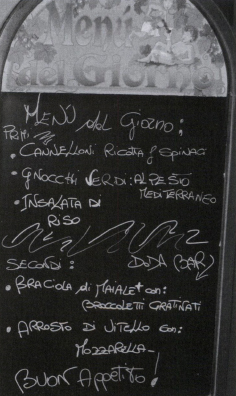
Ecco i secondi. |
|
A: |
Say that the steak is well cooked not rare. |
C: |
Mi dispiace, gliene porto subito un’altra … … Ecco la bistecca con i contorni. |
A: |
Ask for some salt and another fork, the one you have is dirty. |
C: |
Mi dispiace, ecco un’altra forchetta. |
(Later)
A: |
You call the waiter. |
C: |
Cosa desidera? |
A: |
Ask him for two coffees and the bill. |
C: |
Ecco i due caffè, il conto e due grappe, omaggio della casa. |
A: |
You call the waiter and say that there is a mistake, the bill says a litre of wine, not half a litre. |
C: |
Sono davvero spiacente, controllo il conto immediatamente. |
 8 Synonyms
8 Synonyms
For each of the words in the left-hand column, taken from Text 6.1, find a synonym in the right-hand column. The first one is done for you.
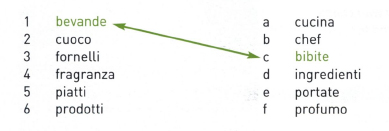
 9 Find the mistakes
9 Find the mistakes
This text is a summary of the interview with Gianfranco Vissani (Text 6.1). But there are some mistakes. Can you spot them?
Gianfranco Vissani, conosciuto ormai da moltissimi anni in tutto il territorio nazionale, afferma in un’intervista che il segreto dei suoi piatti è quello di usare prodotti di ottima qualità. Ma i piatti di Vissani non sono solo famosi per la freschezza e la qualità dei loro ingredienti, bensì anche per la cottura lenta che ne valorizza il sapore. Gli ingredienti preferiti dal cuoco sono il pesce, le verdure e gli aromi, che gli consentono di essere molto creativo.
Text 6.1 Intervista: Gianfranco Vissani
“Per una buona riuscita sono fondamentali gli ingredienti”
“Il segreto della mia cucina? Fate la spesa con passione”
“Il segreto della mia cucina? Sta tutto negli ingredienti”. Così Gianfranco Vissani spiega il motivo del suo successo ai fornelli. Lo chef di Civitella del Lago, il cuoco che da un paio di anni occupa un posto d’onore nelle guide della cucina internazionale, spiega che il momento decisivo per i suoi piatti non è, come si può pensare, quello della cottura.
“Nella mia cucina – spiega Vissani – basata sulle cotture rapide e sulla fragranza dei sapori primari, la qualità della materia prima è fondamentale. Da un prodotto mediocre o cattivo, non può nascere un buon piatto. È importante quindi – conclude lo chef – saper scegliere i prodotti giusti, e i produttori devono migliorare costantemente i loro prodotti”.
Parlando di ingredienti, Vissani aggiunge che preferisce i pesci, i crostacei e le verdure: “Sono prodotti versatili, leggeri, che permettono di liberare fantasia e creatività. Le verdure in particolare sono, secondo me, molto importanti nella cucina di oggi, insieme alle erbe aromatiche, che si possono usare non solo nella preparazione dei cibi, ma anche nell’aromatizzazione delle bevande”.
Adapted from La Repubblica, 9 March 1999
GRAMMAR NOTES
Qualcosa (da mangiare), niente (di buono)
Note these ways of using qualcosa ‘something’ and niente ‘nothing’:
C’è qualcosa da mangiare?
Is there something to eat?
Non c’è niente da fare.
There’s nothing to do (nothing to be done).
Vorrei qualcosa di buono.
I would like something good.
Non vedo niente di bello.
I can’t see anything nice.
Piacere
The most common way to say ‘I Like’ in Italian is piacere ‘to please’ usually in the third person singular (piace) or the third person plural (piacciono), along with the indirect object pronouns mi, ti, gli, etc., to refer to the person who likes or dislikes:
A mio figlio piace viaggiare in treno.
My son likes going by train.
Mi piace molto l’Italia.
I like Italy a lot.
Ti piacciono le paste di mandorla?
Do you like almond cakes?
Gli piace leggere.
He likes reading.
Piacere actually means ‘something is pleasing to me’. This something can be:
• a verb |
mi piace viaggiare (I like travelling) |
• singular noun |
mi piace il pane italiano (I like Italian bread) |
• a plural noun |
mi piacciono queste canzoni (I like these songs) |
Preferire, piacere di più, di meno
You can express a preference by adding di più, di meno to the verb piacere:
Mi piacciono i cani, ma mi piacciono di più i gatti.
I like dogs, but I like cats better.
Lui mi piace molto, ma sua moglie mi piace di meno.
I like him a lot, but I like his wife less.
Or you can use preferire:
Tu cosa preferisci – il tè o il caffè?
Which do you like better – tea or coffee?
Indirect object pronouns: mi, ti, gli, le, Le, ci, vi, gli
When you want to express the idea of ‘to me’, ‘to/for you’ use the indirect object pronouns. Their forms are shown below.

An alternative to gli ‘to them’, used mainly in written Italian, is loro. Unlike the other pronouns, loro comes after the verb:
Abbiamo inviato loro un invito.
We sent them an invitation.
These pronouns normally come immediately before the verb, for example:
Mi piace la pizza.
I like pizza.
Ti piacciono le paste di mandorla?
Do you like almond cakes?
These indirect object pronouns are used with any verb where English uses the preposition ‘to’, for example dare to give’, inviare, mandare, spedire ‘to send’ and with other verbs where the preposition ‘to’ is understood in the sense, such as telefonare:
Mi mandi una cartolina da Parigi?
Will you send me a postcard from Paris?
Gli telefono domani.
I’ll call him tomorrow.
They are also used to express the idea of doing something for someone or even for oneself:
Ti preparo un caffè.
I’ll make you a coffee.
Finally they are used with verbs such as mancare ‘to be missing/lacking’, occorrere ‘to be needed’, piacere ‘to please’, servire ‘to be useful’, ‘to be needed’:
Mi serve una mano.
I need a hand.
Quante uova ci occorrono?
How many eggs do we need?
Mi mancano solo due capitoli.
I’ve got two chapters to go.
Bisogna, aver bisogno di
Both bisogna followed by a verb infinitive, and aver bisogno di followed by a verb or a noun, express ‘need’. Bisogna is used impersonally (‘it is necessary’) and does not apply to any one particular person, whereas aver bisogno di ‘to have need of’ is personalised:
Bisogna partire presto domani.
One has to (we have to) leave early tomorrow.
Ho bisogno di cambiare le gomme.
I need to change the tyres.
Ho bisogno di una mano.
I need a hand.
Modal verbs: dovere, potere, volere
The verbs dovere ‘to have to’, potere ‘to be able to’ and volere ‘to want to’ are very common in Italian and are known as modal verbs. These verbs are commonly found with a verb infinitive, for example:
Devo andare. |
I have to go. |
Posso andare. |
I can go. |
Voglio andare. |
I want to go. |
Their present tense is irregular and the pattern is shown below:
Dovere


Volere

 10 Indirect object pronouns
10 Indirect object pronouns
Fill in the gaps with the regular form of indirect object pronoun (mi, ti, gli, Le, ci, vi, gli) in place of the emphatic form of indirect object pronoun (a me, a te, etc.) given. See example below.
Example
Siete studenti? [A voi) posso fare uno sconto del 20%.
Siete studenti? Vi posso fare uno sconto del 20%.
1 (A Lei) ________ porto subito da bere.
2 (A noi) ________ porta un posacenere, per favore?
3 (A Lei) ________ ricordo che qui non si può fumare.
4 (A lui) ________ dico sempre che la frittura la sera è pesante!!
5 Stasera viene Elena a cena e (a lei) ________ cucino spaghetti all’aragosta.
6 Vieni, (a te) ________ offro un caffè!
7 Ogni anno a Natale (a loro) ________ regalo una cesta piena di specialità natalizie.
8 Perché non (a lui) ________ fate questo favore?
 11 Dovere, potere, volere
11 Dovere, potere, volere
Fill in the gaps with the correct present tense form of dovere, potere, volere.
Scusi, _____________ (1) controllare il conto, c’è un errore.
Cameriere, (noi) _____________ (2) avere il conto per piacere?
Per un tavolo per cinque (Lei) _____________ (3) aspettare ancora un quarto d’ora.
(Tu) _____________ (4) qualcosa da mangiare? In frigo c’è l’anguria!
Ma hai sempre fame!! _____________ (5) mangiare di meno se _____________ (6) perdere peso!
lo vado a mangiare fuori domani sera, _____________ (7) venire anche voi?
Se (noi) _____________ (8) andare “Da Franco”, (noi) _____________ (9) prenotare. Lo sai che è sempre pieno la domenica sera!
Cameriere, _____________ (10) cambiare la tovaglia? Questa è sporca.
Non _____________ (11) bere birra, preferisco la Coca Cola.
 12 I passatempi
12 I passatempi
Listen to these interviews with students about their hobbies (Audio 6.2) and write down in English who does what.
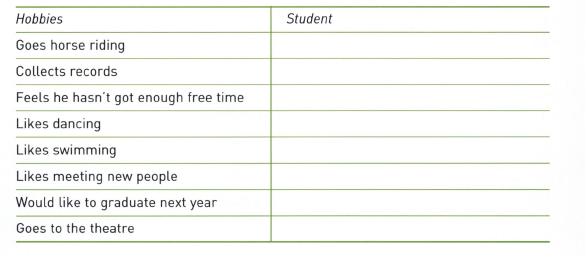
 13 True or false?
13 True or false?
After listening to the interviews again (Audio 6.2), indicate whether the following statements are true, false or uncertain by circling V (vero), F (falso) or N (non si sa). Correct them if they are false.
1 The students are in their third year at university. |
V/F/N |
2 One of them goes to a swimming pool three times a week. |
V/F/N |
3 One of them says she has a boyfriend. |
V/F/N |
4 One of them says she goes to jazz concerts. |
V/F/N |
5 The interviewer asks if they collect stamps. |
V/F/N |
6 One of the students says he loves animals. |
V/F/N |
 14 A survey
14 A survey
Now listen to the interviews again (Audio 6.2) as many times as you like. Then try to fill in the gaps.
(I = interviewer, S = students)
I: |
Ciao, avete qualche minuto? Vi _____________ (1) se vi faccio qualche domanda? Sto facendo uno studio sul tempo libero dei giovani e sui loro hobby. |
SS: |
No, chiedi pure. |
I: |
Voi siete studenti? |
SS: |
Sì, studiamo economia aziendale all’università. |
I: |
A che anno siete? |
S1: |
Siamo al quarto, ci _____________ (2) ancora pochi esami, poi dobbiamo scrivere la _____________ (3). |
I: |
Tu hai tempo libero? |
S1: |
Sì, ma non troppo, non voglio finire fuori corso, devo laurearmi l’anno prossimo. |
I: |
E cosa fai quando non devi studiare? |
S1: |
lo _____________ (4) andare a _____________ (5). I cavalli mi piacciono molto. C’è un _____________ (6) a qualche chilometro da _____________ (7) mia e ci vado almeno una volta alla settimana. La sera quando sono libera esco con il mio ragazzo, di solito andiamo in _____________ (8). Ci piace tantissimo ballare. |
I: |
E tu invece, cosa ti piace fare? |
S2: |
lo sono iscritto ad una _____________ (9) e ci vado tre sere alla settimana, prima di cena. Per me è anche un _____________ (10) di conoscere gente nuova. |
I: |
E tu? |
S3: |
lo adoro andare a teatro. Ogni anno compro un abbonamento al teatro Cavour e non mi perdo nemmeno uno spettacolo. Mi piace anche il nuoto, e vado in _____________ (11) tutte le sere, per un’oretta. |
I: |
E passatempi più tradizionali? Nessuno di voi raccoglie _____________ (12) o monete antiche? |
S1: |
No, ma a me piace tantissimo la musica _____________ (13) e raccolgo vecchi dischi e CD. Ma _____________ (14) avere tanto tempo, e io al momento non ne ho. |
 15 Leisure time and hobbies
15 Leisure time and hobbies
Fill in the table below with your answers in Italian and then, in groups of three or four, talk about your leisure time and hobbies, using the list supplied in Activities 12 and 13.

 16 Fill in the missing verb
16 Fill in the missing verb
Fill in the gaps with the right form of mancare, piacere, servire or occorrere.
Example
Mi _________ 100 pagine per finire questo libro.
Mi mancano 100 pagine per finire questo libro.
1 Carla, noi andiamo a fare la spesa. Ti _________ qualcosa?
2 Mi _________ andare al mare, ma preferisco la montagna.
3 Cosa _________ fare per diventare pilota d’aereo?
4 Gli _________ tutti gli sport invernali, ma in particolar modo lo sci da fondo.
5 Perché quando mi _________ gli occhiali non li trovo mai?
6 Marco ha tutto, ma cosa gli _________ per essere felice?
7 A Carlotta proprio non _________ passare tutte le domeniche con i parenti.
8 Ora la mia amica è in Italia; mi _________ molto.
 17 Questions and answers
17 Questions and answers
Pair up the following questions and answers.
1 Ti piacciono i film di Moretti? |
a Sì, ma purtroppo non ho abbastanza tempo per andarle a vedere. |
2 Ti piacciono le mostre d’arte moderna? |
b Scherzi? Non le piace per niente! È una pigrona! |
3 A Federica piace andare a fare lunghe camminate in montagna? |
c Non so, non la conosco abbastanza per poter rispondere. |
d d Mah, non abbiamo preferenze. |
|
5 Vi piace di più il cinema o il teatro? |
f Li adoro! |
KEY VOCABULARY
A tavola
A meal in Italy can be as simple as a plate of pasta or as elaborate as a four course meal consisting of antipasto, pasta, main course with side salad or vegetables, then dessert. Just in case you want to eat all these courses, here are some key phrases.
antipasto (m.) |
antipasto, hors d’oeuvre, starter |
primo piatto (m.) |
pasta dish |
secondo piatto (m.) |
main course |
contorno (m.) |
side dish, e.g. salad or vegetable |
dolce (m.) |
sweet |
vino della casa (m.) |
house wine |
Some useful phrases
Un tavolo per tre, per favore.
A table for three, please.
Da bere cosa prende?
What would you like to drink?
Come antipasto cosa Le porto?
What can I bring you as antipasto?
Mi porta un altro coltello per favore?
Can you bring me another knife, please?
Mi porta il conto per favore?
Can you bring me the bill, please?